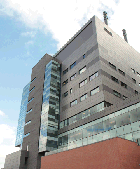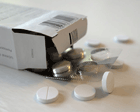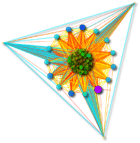 NRx (formerly known as Net Results Express) is UHN's monthly research e-newsletter. Through NRx you can read about ongoing research at our five research institutes, the Princess Margaret Cancer Centre, the Toronto General Research Institute (TGRI), the Toronto Western Research Institute (TWRI), the Toronto Rehabilitation Institute (TRI) and the Techna Institute (Techna).
NRx (formerly known as Net Results Express) is UHN's monthly research e-newsletter. Through NRx you can read about ongoing research at our five research institutes, the Princess Margaret Cancer Centre, the Toronto General Research Institute (TGRI), the Toronto Western Research Institute (TWRI), the Toronto Rehabilitation Institute (TRI) and the Techna Institute (Techna).
In this issue you can read about:
- The grand opening of the Krembil Discovery Tower
- A new treatment for HIV infection
- Predicting the response to a therapy for depression
- A community driven project to identify new cancer markers
- Specialized psychotherapy for terminally ill cancer patients
We hope that you will find NRx informative. If you have feedback or questions, please contact www@uhnresearch.ca.
Christopher J. Paige, PhD, FCAHS
Vice President, Research
University Health Network

UHN's newest research and clinical facility—the Krembil Discovery Tower (KDT)—was officially opened on November 20, 2013. The tower is a nine-story extension of the Toronto Western Hospital and houses open-concept, state-of-the-art research facilities. Unique to KDT are its two Sky Lobbies, which are two-story collaboration centers at each corner of the building where trainees and scientists can gather together to discuss ideas and projects in an informal and relaxed atmosphere while admiring picturesque views of the city. KDT was also built with the environment in mind; it will consume 25% less energy than similar buildings.
The majority of KDT’s new residents are TWRI scientists and trainees. Five floors will be occupied by UHN teams working in a variety of research areas including neuroscience, medicinal chemistry, vision sciences, arthritis and immunity. Dr. Donald Weaver, TWRI’s new Director, will use this newly created research space to help retain and recruit the most talented scientists. KDT will also house TWRI’s Directorate offices, UHN’s Vector Core Facility, U of T’s Tanz Centre for Neurodegenerative Diseases and Altum Health—a UHN enterprise that provides rehabilitation for work-related injuries.
KDT was made possible through a $30 million seed donation from the building’s namesake, the Krembil family, along with $30 million of grant funding from the Canada Foundation for Innovation. Generous donations by individuals, charities and the Toronto General & Western Hospital Foundation contributed to leveraging additional funding from UHN. In total, $174 million was raised to make KDT a reality.

Shortly before publication of this study, dolutegravir received approval from Health Canada for the treatment of HIV infection in Canada.
An international clinical trial led by TGRI Senior Scientist Dr. Sharon Walmsley has demonstrated the effectiveness of a powerful new drug in treating human immunodeficiency virus (HIV) infections. Published in the prestigious New England Journal of Medicine, this study compared the new drug dolutegravir together with abacavir-lamivudine, an existing two drug combination, with the standard clinical treatment for HIV infection, a single tablet combination of drugs including efavirenz, tenofovir and emtricitabine.
A combination of three drugs is the standard used to treat HIV because the virus mutates rapidly and can become resistant to therapy; multiple drugs present more obstacles to the virus than a single drug.
A total of 833 subjects received either the dolutegravir combination or the standard treatment for a period of 48 weeks. The dolutegravir combination was found to lower HIV levels in more patients than the standard treatment and in a shorter time frame. There were fewer side effects than the standard treatment and there was no evidence of resistance against this new drug.
“We’ve shown that dolutegravir plus abacivir-lamivudine is superior to the therapy currently recommended by the guidelines for patients with HIV infection. We are continuing to study its safety and effectiveness over a longer time period, 144 weeks of therapy to be exact, but these primary results suggest that we have a new and well-tolerated treatment option for people living with HIV infection.” says Dr. Walmsley.
This work was supported by ViiV Healthcare.
Dolutegravir plus abacavir-lamivudine for the treatment of HIV-1 infection. Walmsley SL, Antela A, Clumeck N, Duiculescu D, Eberhard A, Gutiérrez F, Hocqueloux L, Maggiolo F, Sandkovsky U, Granier C, Pappa K, Wynne B, Min S, Nichols G; SINGLE Investigators. New England Journal of Medicine. 2013 November 7. [Pubmed abstract]

Functional MRI images of the brain can be used to map activity and connectivity within and between distinct brain regions.
Depressive disorders carry huge societal tolls due to high prevalence, related medical costs and loss to productivity. Despite these burdens, it is still difficult to predict which treatments will benefit patients. To address this issue, TWRI Scientist Dr. Jonathan Downar investigated whether imaging the brain, using functional magnetic resonance imaging (MRI), can predict patient response to repetitive transcranial magnetic stimulation (rTMS). This evolving treatment for depression uses powerful, focused magnetic field pulses to alter activity within emotion-regulating brain regions.
Brain maps were created for 25 patients enrolled in the study before and after rTMS treatment. About half of the patients showed a positive response to treatment, while the other half had little improvement. After analyzing the functional MRI images, Dr. Downar’s team found that patients that responded well to rTMS had high connectivity within certain specific circuits in the frontal lobes of the brain. These regions have been previously linked to depression and, on a functional level, are involved in self-regulation of thoughts, feelings and behaviour.
While it is still unclear whether these results are specific to rTMS treatment, they provide a new level of insight into the neurological basis of depression and may contribute to the development of more effective and personalized treatments.
This work was supported the Ontario Brain Institute, the Canadian Biomarker Integration Network for Depression, the Buchan Family Foundation and the Toronto General & Western Hospital Foundation.
Resting-state cortico-thalamic-striatal connectivity predicts response to dorsomedial prefrontal rTMS in major depressive disorder. Salomons TV, Dunlop K, Kennedy SH, Flint A, Geraci J, Giacobbe P, Downar J. Neuropsychopharmacology. 2013 October 23. [Pubmed abstract]

Visualization of linked cancer markers from multiple clinical data sets generated by UHN-developed NAVIGaTOR software.
This month the Mapping Cancer Markers (MCM) project was officially launched. Led by Princess Margaret Cancer Centre Senior Scientist Dr. Igor Jurisica, this ambitious project seeks to discover specific groups of biological indicators known as “markers”, such as genes and proteins, which can be used to improve detection, diagnosis, prognosis and treatment of cancer.
To identify new markers, thousands of patient samples will be analyzed and billions of marker combinations will be tested. Dr. Jurisica’s research group has developed specialized software that can focus on relevant data subsets, reducing the amount of worked needed to be done. Nevertheless, this process requires a very large amount of computer processing power. This project is powered by IBM’s World Community Grid, a community of about one million users and 2.5 million devices that provide spare computing power to perform computation on several computationally-intensive projects. Using this Grid, MCM researchers break down this overwhelming process into smaller, manageable tasks which can be then computed via donated computational power from World Community Grid volunteers.
To learn more about this project or support the research program, click here.

A recent study found that more than one quarter of patients dying of cancer suffered from depression.
The psychological well-being of patients diagnosed with terminal diseases can decline over time, compromising their quality of life, compliance with medical treatments and relationships with caregivers. A team led by Princess Margaret Cancer Centre and TGRI Senior Scientist Dr. Gary Rodin and Clinician Scientists Drs. Christopher Lo and Sarah Hales, conducted a pilot study to investigate the practicality and benefit of delivering a customized psychotherapy program, known as Managing Cancer and Living Meaningfully (CALM), to promote psychological well-being in patients with advanced or metastatic cancer.
The study followed 50 terminally ill cancer patients over a six-month period as they received up to eight one-on-one therapeutic sessions delivered by specially-trained social workers or medical doctors. To evaluate the effectiveness of the therapy, researchers used self-assessment questionnaires completed by participants before, during and after the study.
Researchers found that CALM was associated with a small but significant decrease in depressive symptoms and anxiety related to death, and an improvement in spiritual well-being. These preliminary results are encouraging and support the implementation of a larger randomized clinical trial to evaluate the effectiveness of CALM on patients with terminal diseases.
This work was supported by the University Health Network Department of Psychiatry, the Canadian Institutes of Health Research, The Princess Margaret Cancer Foundation and the Ministry of Health and Long-Term Care.
Managing Cancer And Living Meaningfully (CALM): Phase 2 trial of a brief individual psychotherapy for patients with advanced cancer. Lo C, Hales S, Jung J, Chiu A, Panday T, Rydall A, Nissim R, Malfitano C, Petricone-Westwood D, Zimmermann C, Rodin G. Palliative Medicine. 2013 October 29. [Pubmed abstract]
 The Spondylitis Association of America (SAA) recently honoured TWRI Affiliate Scientist Dr.
The Spondylitis Association of America (SAA) recently honoured TWRI Affiliate Scientist Dr.